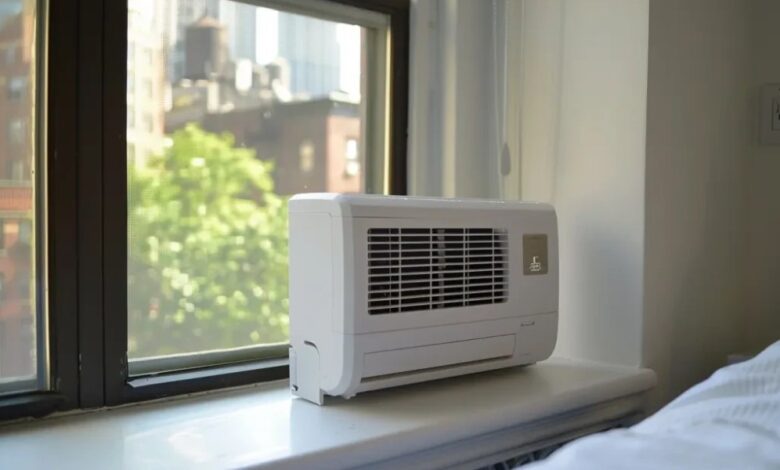A Practical Guide To Choosing A Small Window AC For Efficient Cooling

When summer temperatures rise, staying cool in a compact living space like an RV, bedroom, or studio apartment can be challenging.¬Ý
A small window AC offers a practical and cost-effective solution without taking up floor space or requiring complex installations.¬Ý
This guide explores how to choose the right ductless window AC unit, how inverter technology improves efficiency, and what key features matter most in everyday use.
Why Choose A Small Window AC?
Space-Saving Design For Compact Rooms
If you’re short on square footage, every inch counts. Unlike portable units or split systems that require hose connections or wall modifications, a window AC fits right into your existing window frame. It’s ideal for renters, students, or anyone living in smaller spaces such as:
- Studio apartments
- Dorm rooms
- Small bedrooms
- RVs or trailers
It doesn’t intrude into your living area and requires minimal setup.
Easy To Install And Relocate
Small window ACs are relatively lightweight compared to central or split systems.¬Ý
Most models come with a basic installation kit, including support brackets and side panels, making it easier to set up without professional help. This portability also allows you to remove or relocate the unit seasonally.
Understanding Inverter Technology In Window ACs
What Is Inverter Technology?
Traditional air conditioners turn the compressor on and off repeatedly to maintain room temperature. In contrast, inverter air conditioners continuously regulate the compressor’s speed. This results in:
- Less energy consumption
- Smoother operation
- Quieter performance
In a small window AC, inverter technology helps maximize efficiency without compromising cooling performance.
Real Savings On Energy Bills
One of the biggest advantages of an inverter window AC is energy savings. Inverter models typically consume at least 30% less energy than conventional non-inverter units. This makes them a smart investment for anyone concerned about rising electricity costs.
Key Features To Look For In A Small Window AC
When shopping for a small window air conditioner, here are the features that matter most.
BTU Range That Matches Your Room Size
Cooling capacity is measured in BTUs (British Thermal Units). Choosing the right size ensures efficient cooling without overworking the machine.
| Room Size | Recommended BTU |
| Up to 150 sq ft | 5,000–6,000 BTU |
| 150–250 sq ft | 6,000–8,000 BTU |
| 250–350 sq ft | 8,000–10,000 BTU |
| 350–520 sq ft | 10,000–12,000 BTU |
For small rooms like RVs, small bedrooms, or tiny apartments, an 8,000–12,000 BTU window AC usually offers the right balance of power and efficiency.
Multiple Cooling And Fan Speeds
Look for a model that offers at least two fan and cooling speeds. This allows better control over how quickly the room cools and how much noise the unit makes.¬Ý
Some models include a high-speed mode for rapid temperature drop and a low-speed mode for quiet, steady cooling at night.
Quiet Operation For Better Comfort
Noise is a common complaint with budget air conditioners. An inverter-based small window AC reduces vibration and noise thanks to balanced motor operation. This can be especially important in bedrooms or shared spaces.
Directional Airflow Control
A four-way adjustable louver system allows you to direct cool air exactly where it’s needed. This helps the room cool faster and eliminates uneven temperature zones.
Washable, Reusable Filter
A removable filter that can be rinsed and reused not only saves money but also keeps the air cleaner. Regular cleaning ensures your AC maintains peak performance without circulating dust or allergens.
Installation And Maintenance Tips
Easy Setup With Window Kit
Most small window ACs come with a complete installation window kit. The hardware typically includes:
- Adjustable side panels
- Mounting brackets
- Screws and fasteners
- Weather-stripping foam
These kits are designed to fit standard windows, usually between 23″ to 36″ wide. Always double-check your window measurements before purchase.
Keep The Filter Clean
To ensure proper airflow and efficiency, clean the filter once every two weeks during heavy use. Rinse with warm water and dish soap, then air-dry thoroughly before reinstalling. A clogged filter restricts airflow and forces the unit to work harder, increasing energy use.
Inspect Seals For Air Leaks
After installation, use foam or sealant to eliminate gaps between the unit and the window frame. This prevents warm air from seeping in and cold air from escaping.
Benefits Of Upgrading To A Modern Small Window AC
Fast Cooling When You Need It
Inverter models are designed to deliver maximum power when there is a big difference between indoor and outdoor temperatures.¬Ý
They start strong, quickly bringing the room to a comfortable level before switching to a lower, energy-efficient mode.
Cleaner Air And Less Humidity
Most small window AC units also function as dehumidifiers. In humid climates, this is a huge benefit as it reduces stickiness and improves comfort.¬Ý
Combined with an eco-friendly reusable filter, the air in your room stays fresh and breathable.
Less Environmental Impact
Compared to large HVAC systems, a small window AC consumes fewer resources and uses refrigerants with lower environmental impact. It’s a more sustainable choice for climate-conscious users.
Practical Use Cases
RV And Camper Living
Travelers and vanlifers often struggle with keeping cool in enclosed mobile spaces. A compact window AC can be fitted into custom RV window frames to provide reliable cooling without draining the battery.
Home Office Setups
Working from home means comfort matters. Installing a small window AC in a home office helps regulate temperature without having to cool the entire house.
Student Dorm Rooms
College students often live in small, poorly ventilated rooms during the summer. A portable window AC offers a simple fix without permanent installation.
Things To Consider Before Buying
Check Your Window Type
Not all windows are compatible with every unit. Double-hung windows are ideal for most standard window ACs. Avoid casement or slider windows unless the unit specifically supports them.
Confirm Power Requirements
Some units require a standard 115V outlet, while higher BTU models may need a 230V connection. Check your power supply to avoid compatibility issues.
Think About Storage
When the season ends, you’ll need to remove and store the unit. Choose a model that’s compact and easy to lift if you plan to uninstall it each year.
Conclusion
A small window AC offers more than just relief from the heat ‚Äî it brings efficiency, flexibility, and long-term savings in a compact package.¬Ý
With modern features like inverter technology, multiple fan speeds, and reusable filters, it’s a smart solution for anyone living in a smaller space.
While it won’t replace central air in large homes, for single-room cooling or mobile use, it’s one of the most effective options available today.





